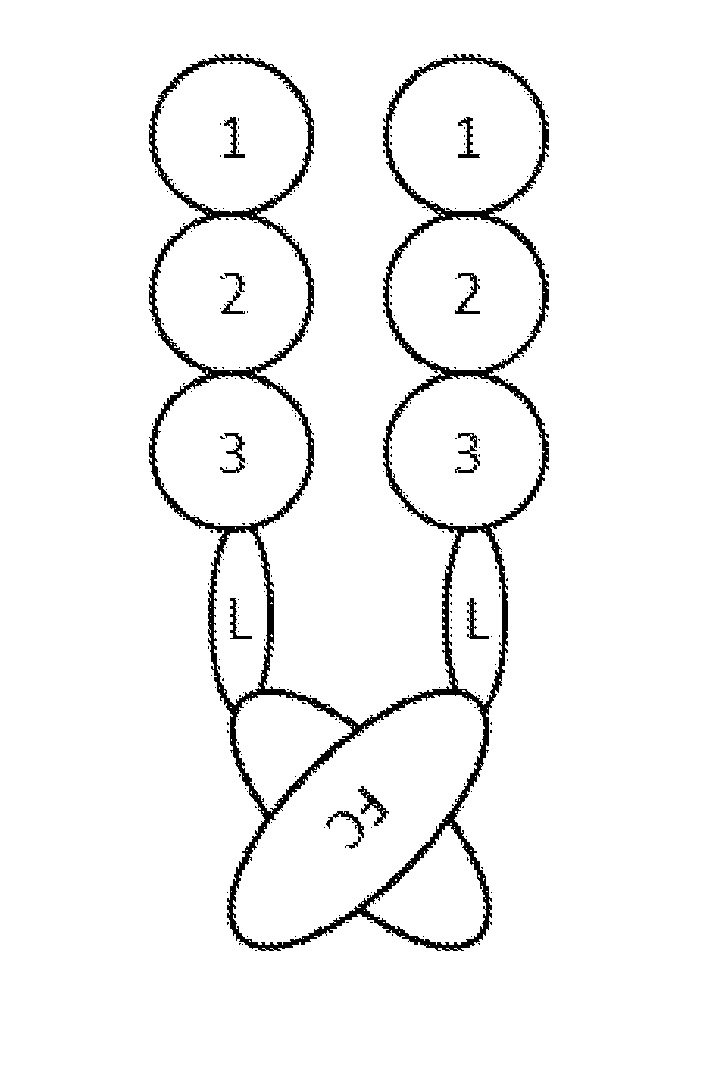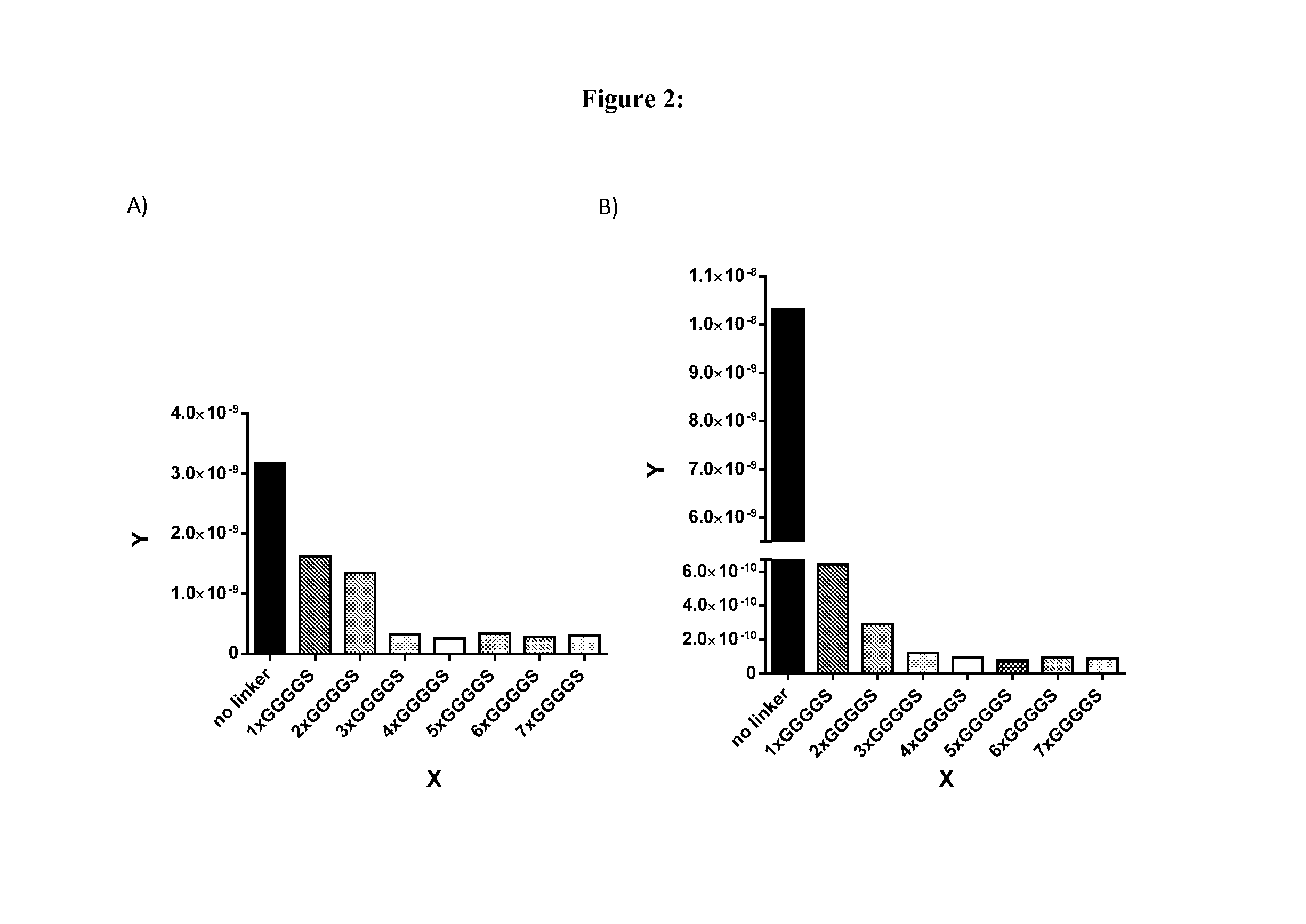Pdgfrbeta-fc fusion proteins and uses thereof
a technology of fusion proteins and pdgfrbeta, which is applied in the field of platelet-derived growth factors, can solve the problems of plasma proteins leakage into the vitreous of patients, inability to limit and inability to achieve the goal of reducing the formation of new vessels in the retina in patients
- Summary
- Abstract
- Description
- Claims
- Application Information
AI Technical Summary
Benefits of technology
Problems solved by technology
Method used
Image
Examples
example 1
Generation of Different Recombinant PDGFRbeta Fc Constructs
[0155]To generate different Fc fusion proteins (SEQ ID NO: 15-25) the extracellular domains 1-3 of PDGFRbeta, derived from UNIPROT ID P09619 (SEQ ID NO: 2 and FIG. 1A) were C-terminally fused to a human IgG1 Fc-part (SEQ ID NO: 14). This was done either directly (SEQ ID NO: 15) or via different amino acid linkers (SEQ ID NO: 16-25 see FIG. 1 B). The linker was a GGGGS linker selected from SEQ ID NO: 7-13, i.e.
SEQ ID NO 7:GGGGS (1x GGGGS),SEQ ID NO 8:GGGGSGGGGS (2x GGGGS),SEQ ID NO 9:GGGGSGGGGSGGGGS (3x GGGGS),SEQ ID NO 10: GGGGSGGGGSGGGGSGGGGS (4x GGGGS),SEQ ID NO 11:GGGGSGGGGSGGGGSGGGGSGGGGS (5x GGGGS),SEQ ID NO 12:GGGGSGGGGSGGGGSGGGGSGGGGSGGGGS (6x GGGGS),SEQ ID NO 13:GGGGSGGGGSGGGGSGGGGSGGGGSGGGGSGGGGS (7x GGGGS),
or a linker selected from SEQ ID NOs: 4-6, i.e SEQ ID NO 4: EPKSC, SEQ ID NO 5: EPKSS or SEQ ID NO 6: GGGGG. The gene of the respective Fc fusion protein was cloned into a suitable expression vector based on a CM...
example 2
BiaCore
[0157]Binding affinities (KD values) of PDGFRbeta-Fc fusion proteins were measured by using surface plasmon resonance assays. Experiments were performed using a Biacore T200 instrument (GE Healthcare Biacore, Inc.) with Series S Sensor Chips CM5 (GE Healthcare Biacore, Inc.). Binding assays were carried out at 25° C. with assay buffer HBS-EP+ supplemented with BSA (Sigma) and NaN3 (10 mM HEPES pH 7.4, 500 nM NaCl, 1 mg / ml BSA, 0.05% SP20, 0.05% NaN3). Fc fusions were captured with an anti-hIgG capture antibody covalently immobilized to the chip surface via amine coupling chemistry. Reagents for amine coupling (1-ethyl-3-(3-dimethylaminopropyl)carbodiimide hydrochloride (EDC), N-hydroxysuccinimide (NHS), ethanolamine-HCl pH 8.5) were used from the Amine Coupling Kit (GE Healthcare, product code BR-1000-50). anti-hIgG capture antibody and immobilization buffer (10 mM sodium acetate pH 5.0) was used from the Human Antibody Capture Kit (GE Healthcare, BR-1008-39). The sensor chip...
example 3
Cell-Based Assays to Determine In Vitro Potency of PDGFRbeta-Fc Fusion Proteins
[0161]PDGFRbeta-Fc fusion proteins have been characterized in vitro using Normal Human Dermal Fibroblasts (NHDF) (NHDF juvenile foreskin, Promocell, Catalog Number: C-12300, cultivated according to provider's manual, (http: / / www.promocell.com / fileadmin / promocell / PDF / C-12300.pdf) cell-based assays in which two downstream signaling events after stimulation with human PDGF-BB (Recombinant Human PDGF-BB, CF, R&D Systems, Cat. No. 220-BB-010) were assessed:[0162]pPDGFRbeta Tyr751 phosphorylation (Meso Scale Phospho PDGFR-beta (Tyr751) Assay Whole Cell Lysate Kit K150DVD-1)[0163]pAKT Ser473 phosphorylation (Meso Scale Phospho (Ser473) Total AKT Assay Whole Cell Lysate Kit K15100D-1)
[0164]NHDFs were starved for 3 h with serum-free culture medium, stimulated for 30 min with 6.3 ng / ml (for pAKT assays) and 50 ng / ml (for pPDGFRbeta assays) PDGF-BB (R&D Systems, Recombinant Human PDGF-BB, CF; 220-BB-010), which was ...
PUM
| Property | Measurement | Unit |
|---|---|---|
| pH | aaaaa | aaaaa |
| Tm | aaaaa | aaaaa |
| concentration | aaaaa | aaaaa |
Abstract
Description
Claims
Application Information
 Login to view more
Login to view more - R&D Engineer
- R&D Manager
- IP Professional
- Industry Leading Data Capabilities
- Powerful AI technology
- Patent DNA Extraction
Browse by: Latest US Patents, China's latest patents, Technical Efficacy Thesaurus, Application Domain, Technology Topic.
© 2024 PatSnap. All rights reserved.Legal|Privacy policy|Modern Slavery Act Transparency Statement|Sitemap



